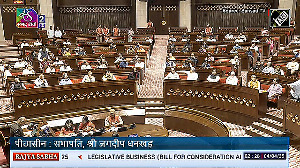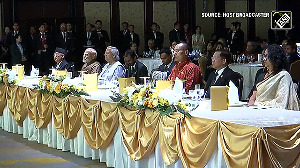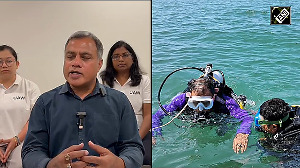 The role of women as soldiers and warriors has been evident in history the world over for centuries. As early as the 15th century, Joan of Arc, is said to have led the French army during the hundred year's war against England.
The role of women as soldiers and warriors has been evident in history the world over for centuries. As early as the 15th century, Joan of Arc, is said to have led the French army during the hundred year's war against England.
More recently, during World War I, the service of women was utilised for nursing duties in the war zone. Russia is said to have raised a few women battalions for combatant roles during the war but the concept did not take off and these battalions were disbanded soon after.
The role of women expanded rapidly during World War II. They were inducted into war industries, building ships, aircraft, vehicles, and weaponry.
They provided logistic support for soldiers and soon enough gained an entry into professional areas of work that were previously the preserve of men.
Thousands of women joined defensive militias in countries across Europe and America. This was also the period that witnessed a perceptible increase in the number of women serving in the military itself.
Indian military history also boasts of a fair share of women soldiers, Razia Sultan and the Rani of Jhansi being the most famous.
Women were also a part of the Indian National Army raised by Subhash Chandra Bose to fight the British. Post independence, women have for long been serving the Indian Army in the Army Medical Corps, Army Dental Corps and Military Nursing Service.
In all these branches they have played a commendable role and have risen to high ranks within their cadre. However, beyond this the Indian Army did not induct women for 47 years, after independence. It is said that the idea to induct women into the Indian Army first came after a senior army officer witnessed lady officers giving the guard of honour in the United States of America. The first batch of Short Service Commission women officers was inducted into the Indian Army in the year 1993.
This milestone was achieved through generation of considerable debate, both, within and outside defence circles. The debate acquired the hue of a gender issue with terms like equality of the sexes and discrimination against women thrown in for good measure.
Since the Indian Constitution guarantees equality of opportunity for all, irrespective of sex, it was considered only right that women should be allowed to join the army as well. The more vociferous among the women activists even referred to this as the "last male bastion", with a liberal dash of self-righteousness and victory in their speech.
At present there are about 1,000 women officers in the Indian Army and they account for about 2.44 per cent of the total strength of the officer cadre. This number has grown steadily over the years and it is a compliment to the Indian Army that it has moulded itself to make place for these women officers and maintain an open mind about their continued presence. It is, after all, not easy to effect changes of such an intrinsic order, in a large conventional and tradition driven organisation like the Army.
Women in the Indian Army were inducted primarily in the non-combat arms like the Judge Advocate General branch, Army Service Corps and Army Education Corps in addition to the traditional services that they were serving in.
Soon enough they found a place for themselves in services like Corps of Signals, Engineers, Intelligence Corps etc. Apparently they have proved their ability and discharged their duties suitably enough, for what started as a five-year stint has been increased to ten and subsequently fourteen years for a few disciplines. Now two departments i.e. JAG and AEC have granted permanent commission to the women in the Indian army.
Change is often accompanied by a measure of initial chaos, which gradually settles down, given time. Chaos, however, is something that an organisation like the army simply cannot afford, since what is at stake here is the entire nation's security and honour.
There have, no doubt, been teething problems but these are no more than in any other employment sector. In fact, it is to the credit of the Indian Army that its in-built mechanism of grievance redressal is sufficiently well equipped to deal with such issues.
The pertinent questions in this regard are -- has the experiment been a success? Should it be extended? These apart, there are some subsidiary questions that need answering as well. What for instance, is the special role that women can or should discharge in the Army? What qualities do they bring to these jobs to make them more efficient to discharge the same?
The lady officers, as women are addressed in the army, seem to be quite happy with their chosen profession. An interaction with them clearly illustrates their professionalism and will to stand tall next to their male colleagues, in the discharge of their duties.
A spirit of comradeship has developed between the younger generation of officers of both genders, who have trained and grown together in service. They exhibit a rare comfort level, which has developed with time. Therefore, it can be safely presumed that the experiment has been a resounding success and there is no case to now look back on the issue.
Organisations like education, medical services, logistics and technology driven segments like communication and engineering are well established niches for women.
These bring in to call such qualities of the head and heart, which are well suited to women. Research has shown that women are more perceptive and intuitive and endowed with organisational skills that help plan right down to minute detail.
They have the ability to empathise and understand, thus making them excel in all such fields that deal with interaction with human personnel; these are fields where women in the army can make a sterling contribution.
On hindsight it seems that the entire debate that was ignited, when the idea was in its nascent stage was not unprecedented.
Whenever, women have first stepped into essentially male worlds, the opposition has always been there. Such debates have had more to do with ideologies, principles, traditions and safety of the women. However now, almost two decades post the event, one can sit back and take a more rational view of things and feel that the idea of women in the Indian Army has finally arrived.
People often wonder as to why women would like to join the Army in the first case. After all it is a tough life with eternal questions of modesty and propriety coming to the fore.
The Indian Army offers job challenges that are difficult to come by in most other sectors of employment. The thrill and pride of serving one's motherland is an additional attraction. All this comes along with a well laid down code of conduct that makes things far more orderly and easy to adhere to.
Women, in fact, feel more safe within the Army than they do in other services of a similar genre' in the civil sector. It is for all these reasons, in addition, to attractive pay packets that women like to choose the army as a career option.
There are still questions that remain unanswered and in fact open to debate. The foremost of course is, whether women should be inducted into the combat arms as well.
The fact is that no active army in the world has inducted women in its combat arms. Even the army of Israel, which is considered most gender neutral, goes by role suitability, rather than mere lip service to gender equality.
Nature has given different attributes to both men and women and it is only right that to optimise one's productivity and the organisation's efficiency, the right person be chosen for the right job. Issues like gender discrimination have no place in decisions like these.
Most important, there is a lot at stake and such decisions should be taken only after careful consideration and more important - gradually.
So far, the induction of women into the Indian Army has been a successful experiment and the credit for this goes, both, to the organisation as well as the women. In order to ensure that future experiments are just as successful, one must proceed with a measure of foresight and judicious contemplation.







 © 2025
© 2025